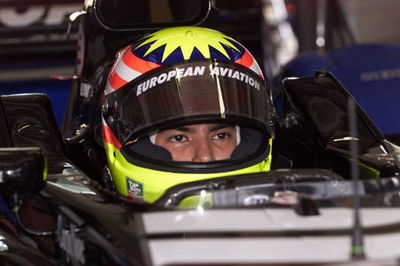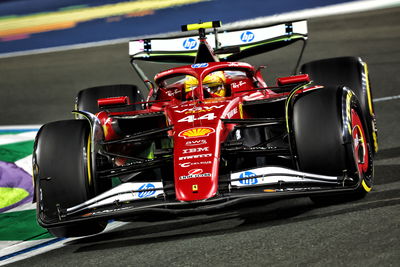Q&A: Alex Yoong.
Malaysia's Alex Yoong last week completed his first Formula One test with the European Minardi team, impressing observers as he dealt with the step up in performance with flying colours.
The historic occasion also marked a new milestone in Malaysia's motorsport history, as Yoong became the first representative of his country to pilot an F1 machine, clocking a fastest time of 1min 29.991secs during 67 laps of Mugello, and covering a race distance. Minardi's official test-driver Andrea Piccini's best time was 1min 31.260secs over 65 laps.

Malaysia's Alex Yoong last week completed his first Formula One test with the European Minardi team, impressing observers as he dealt with the step up in performance with flying colours.
The historic occasion also marked a new milestone in Malaysia's motorsport history, as Yoong became the first representative of his country to pilot an F1 machine, clocking a fastest time of 1min 29.991secs during 67 laps of Mugello, and covering a race distance. Minardi's official test-driver Andrea Piccini's best time was 1min 31.260secs over 65 laps.
Q:
You said after your test with Minardi in Mugello that you have to brake with your left foot, why is that?
AY:
The Minardi PS01 was set up with the brake pedal on the left of the steering column. So it's a case that, even if I want to brake with my right foot, I can't.
Q:
Are all F1 cars like that, and was it difficult for you?
AY:
No, not all F1 cars are like that. We could have changed the footwell set-up, but I decided to get used to this technique at the test as it will be useful for my driving in the long term. Yes, it was difficult for me as I don't have the muscle memory in my left foot that I have in my right but, with more laps in the car, I gradually could apply the correct pressures and react to situations better. Most F1 drivers nowadays use the left foot braking technique, so it's better for me to be comfortable with it early.
Q:
What are your impressions of the biggest differences between a Formula 3000 car and the Formula One car?
AY:
The main differences are the downforce and the power. The extra downforce allows you to carry much more speed through the quicker corners and stop really quickly. The power difference is some 800bhp in an F1 car, compared to 470bhp in a F3000 car and 530bhp in a Formula Nippon car, so you can imagine it.
Q:
You have said in the past that Formula Nippon is a good grooming step for drivers going into F1 - in which areas of the Formula Nippon car that are similar to the F1 car?
AY:
There are no significant similarities really, as a F1 car is really all on its own. For sure, the step up from FNippon to F1 is just as big as the step up from F3 to F3000 or FNippon. However, my personal experience in FNippon did help me to understand the myriad of engineering that has gone into building and racing cars at this level. This has enabled me to be well prepared in car setting skills and the necessity of working well with my engineer and mechanics to make the car go quicker. If there is any similarity, I would say that the physical demands of driving the Minardi F1 car is not much greater than the FNippon car.
Q:
Can you tell us what you see of the track when you are driving the F1 car at speed. Is it the same as what the TV viewers see when the directors switch over to the onboard camera?
AY:
No, it is very different because of the vibrations of the car. You can hardly see the track when the car goes over the bumps. For a start, the onboard camera lens are so sophisticated nowadays that they probably sit on compensating liquid suspensions to off-set the vibrations of the car. If you remember the early day onboard cameras where all you see are blurred visions with horizontal lines when the car goes over a bump, that's what we F1 drivers see. The car's vibrations are much greater than a FNippon car due to the engines revving to 17,000rpm and more, and also due to it's much more rigid construction and low weight. You have to drive to memory when your vision is blurred from the vibrations created over rough sections of a circuit.
Q:
What about the cockpit space as compared to your LeMans team's Reynard?
AY:
I have slightly more elbow room in the Minardi PS01 and the steering wheel is closer to me as a result. I therefore have more leverage in controlling the steering wheel. However, I have to now further develop my biceps and triceps, since driving the FNippon car with straighter arms meant more strain on my shoulders and less strain on my biceps and triceps. I am physically quite well prepared as I am, but there's nothing wrong with being even better prepared.
Q:
There are so many fly-by-wires controls in a F1 car today. Was it easy adapting to the multi-lever steering wheel?
AY:
I had no big problems in that respect. It was a matter of getting used to it. The one small problem I had was always searching for my gear-lever on my right whenever I was on my out-lap. It was very funny and it showed that, even though my mind knew that the gear-lever was not there, my body was still reacting like it was there. The electronic steering wheel is an amazing piece of equipment. Almost everything you want to do with the car is controlled electronically now. Everything except the throttle, the steering input and the braking.
Q:
What is your own personal view of your performance over the two days in Mugello.....please be as strong a critic as you can?
AY:
I did a professional job and did everything the team asked of me. I also think that what I did was more than what many expected me to deliver.
Q:
What's next in your programme now?
AY:
The immediate next thing for me is to do well in the Monza test which is scheduled for the 18-19 July. The immediate next thing for my management team is to finalise the support from the sponsors to come into F1 with me. I understand that Minardi will be sending a confidential report to our Minister of Youth and Sports immediately after the test, and I hope that what everyone saw in my efforts will reinforce the faith which the government of Malaysia and Magnum Corporation have in me. We'll move on from there to hopefully enable me to start my first F1 race for my supporters, my country and for myself. I can hardly wait.
Q:
Any closing advice?
AY:
I like to say this to all young Malaysians who have set their minds on being a Formula One driver: it is possible, and it is worth the great sacrifices that you and your family will be making. Just be very focused and keep working very hard at it. I also like to thank all my sponsors and Magnum Corporation, as well as the Government of Malaysia and my supporters who have stood by my side all these years for finally getting where I am today.










